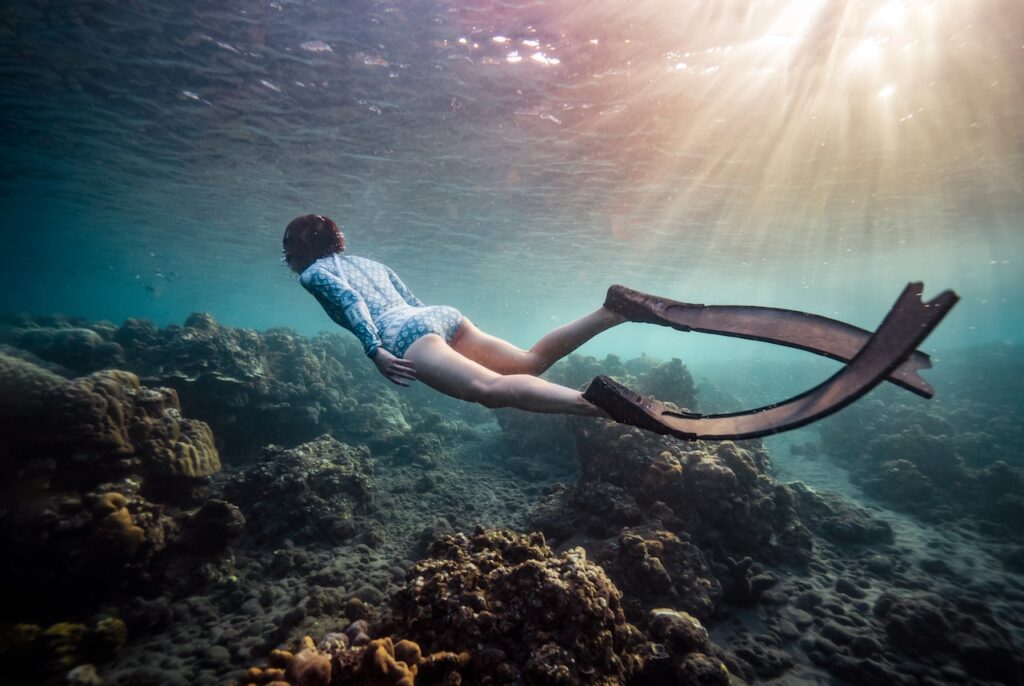Freediving is a captivating and meditative sport, allowing us to observe the ocean with less gear than scuba diving. However, choosing the right equipment can be confusing, especially for entry-level divers. The right tools can make a dive comfortable and improve performance. What’s more, choosing the best equipment for your dive and experience level is essential to ensure the dive isn’t risky and spoiled before it even starts.

This article dives deep into the world of freediving equipment and provides you with the tools you need to make informed decisions. Whether you’re a seasoned diver or just starting, this article will empower you to take the plunge and explore the beauty of the underwater world with confidence. So, grab your mask, put on your fins, and let’s dive into the world of freediving equipment.
What freediving equipment do divers need?
There are numerous pieces of equipment that freedivers need. While you need minimal gear to get started, some of these pieces may enhance your dive and create a safer experience.
Freediving suit
A wetsuit or drysuit is essential for keeping the diver warm and protected in the water.
Fins
Fins help the diver move through the water efficiently and effectively.
Mask
A mask provides clear underwater vision and protects the eyes.
Snorkel
A snorkel allows the diver to breathe while floating on the surface.
Weight belt
Weights help the diver achieve neutral buoyancy.
Dive computer
This device monitors and tracks the dive time and depth.
Safety marker buoy
A safety marker buoy is used to observe the diver’s location on the surface in an emergency.
Dive knife
This tool is used to cut lines and is also essential in an emergency.
Dive watch
A dive watch can measure dive time and depth.
Dive flag
A dive flag marks the dive site and indicates divers are in the area.
Signaling device
A signaling device helps people communicate with other divers or surface support.
It’s crucial to note that some of this equipment is mandatory depending on the country, agency, or instructor. Therefore, you should always check the regulations in your diving area.
How to choose freediving equipment
Choosing the best freediving equipment depends on your individual needs. From wetsuits and fins to dive watches and safety markers, we’ll guide you through selecting equipment that fits your individual preferences. Here are our 7 best tips to help you make the best choices:
Consider which diving you’ll be doing
Different types of freediving require different equipment. For example, if you plan deep dives, you’ll need fins with a longer blade for more power. In comparison, you’ll need more flexible fins if you plan to do surface swimming and snorkeling.
Consider the water temperature
The water temperature will determine what type of suit you need. If you are diving in cold water, you’ll need a thicker wetsuit or drysuit with a hood, gloves, and boots. In case you are diving in warm water, a thinner wetsuit or drysuit without a hood, gloves, and boots will be more comfortable.
Look for quality materials and construction
Look for equipment made of durable and rust-resistant materials, such as stainless steel or lead-coated materials for weights. Also, look for well-constructed equipment that has undergone testing for safety and reliability.
Determine your budget
Freediving equipment can be expensive, so it’s essential to set your budget before making a purchase. While you want to invest in quality equipment, you don’t want to overspend.
Consider the brand
Research the brand you are considering, read reviews, and look for a company with a great reputation for quality and customer service. For example, Agulhas Ocean offers state-of-the-art freediving equipment. Since many people freedive so they don’t disrupt the ocean environment, Agulhas provides a sustainable, safe, and effective option for all divers.
Try before you buy
When possible, try on different wetsuits, fins, and masks to see what feels most comfortable. You can also test fins in a pool or snorkel in a shallow area to see how they perform.
Get the right size
Ensure that you get the right size for your wetsuit, fins, mask, and weight belt. A suit that is too tight will be uncomfortable and restrict movement, while a wetsuit that is too loose will allow water to flood in and make you cold. Fins that are too small will be uncomfortable, while fins that are too large will be difficult to control.
Considering these tips, you’ll find the best freediving equipment to suit your individual preferences, so you can enjoy a safe and pleasant diving experience.

